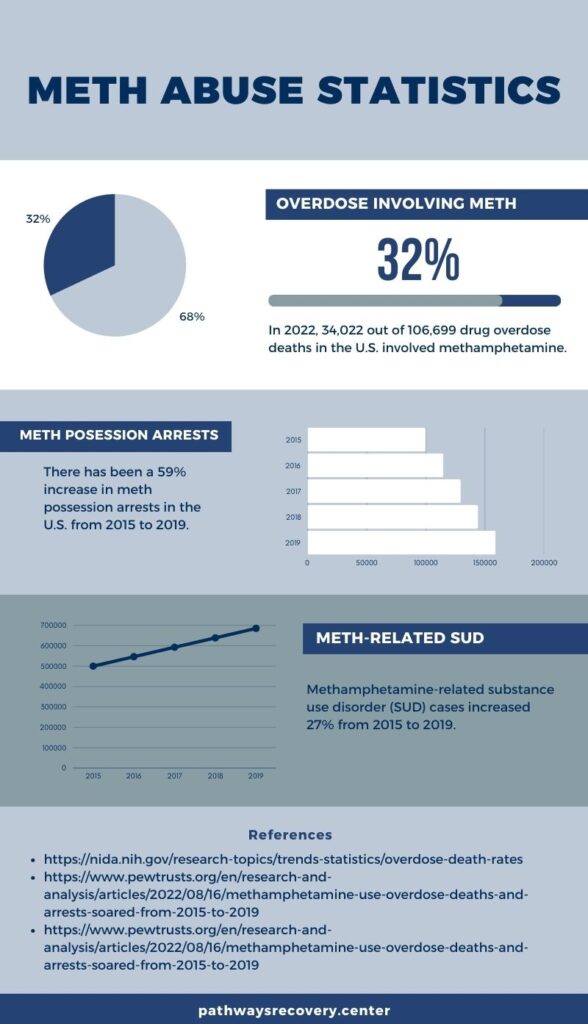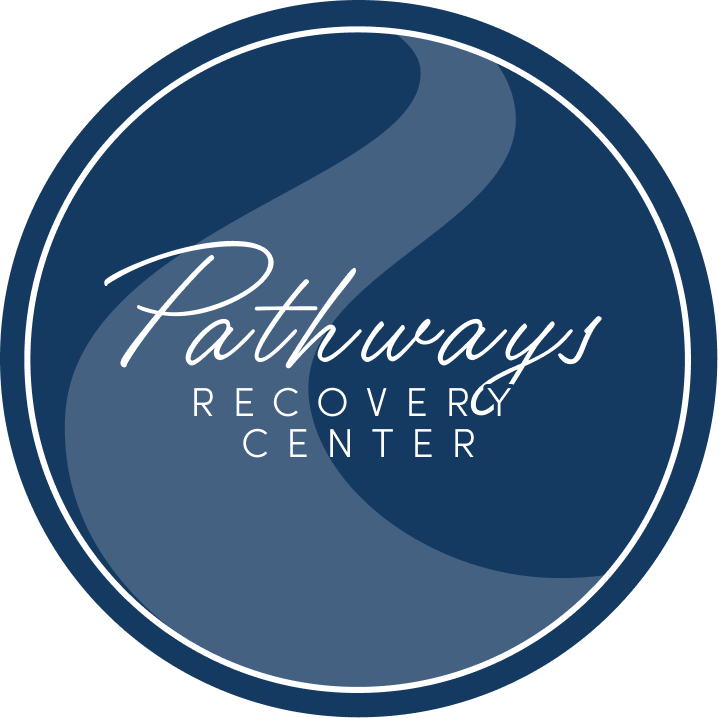Understanding the Rising Death Toll of Meth Abuse
Methamphetamine abuse has reached alarming levels in the United States, leading to a dramatic rise in overdose deaths. In recent years, the number of meth-related fatalities has skyrocketed, with deaths increasing from 5,716 in 2015 to 34,022 in 2022.1 Once considered less fatal than opioids, methamphetamine is now a major contributor to drug overdose deaths, mainly due to its frequent combination with fentanyl, a potent synthetic opioid.
Key Factors Driving the Increase:
- Higher Potency and Availability – Meth available today is more potent and widely accessible than ever before.
- Fentanyl Contamination – Many meth-related deaths now involve fentanyl-laced meth, making overdoses more frequent and deadly.
- Lack of Medical Treatments – Unlike opioid use disorder, there are no FDA-approved medications for meth addiction, making treatment more difficult.
- Rising Meth Use – From 2015 to 2019, methamphetamine-related substance use disorders increased by 37%, contributing to the overdose crisis.2
In this resource, we’ll explore the latest statistics on meth-related deaths, examine the causes behind the rise, and review the public health response to this growing crisis.
How Many Deaths Were Caused by Meth Abuse?
According to the National Institute on Drug Abuse (NIDA), drug overdose deaths involving psychostimulants with abuse potential, primarily methamphetamine, increased from 5,716 in 2015 to 34,022 in 2022. This trend has been rising steadily since 2014, regardless of opioid involvement.1
A separate Pew Trusts analysis found that between 2015 and 2019:
- Arrests for meth possession increased 59%.
- The number of people in the U.S. diagnosed with a methamphetamine-related substance use disorder (SUD) rose by 37%.
- Overdose deaths involving meth more than doubled.2

Methamphetamine-Related Deaths by State
Meth-related deaths vary across different states, with some regions experiencing significantly higher death rates. For example:
- California reported a methamphetamine-related death rate of 26.9 per 100,000 people and a total of 10,952 deaths.3
- In 2021, Oregon saw a 42% increase in methamphetamine-related overdose deaths compared to the previous year.4
- West Virginia, one of the hardest-hit states by the opioid epidemic, has also seen a significant rise in meth-related deaths, with many cases involving meth laced with fentanyl.5
Why Are Meth-Related Deaths Increasing?
Several factors contribute to the alarming rise in methamphetamine-related deaths, making it one of the most pressing public health crises in the United States.
Increased Availability and Potency
Methamphetamine has become more potent and widely available over the past decade. Advances in illicit drug production have led to meth that is nearly 100% pure, making it far more dangerous than earlier formulations.6 This increase in purity raises the risk of overdose and severe health complications. The drug has also become cheaper, increasing accessibility to a broader population. Law enforcement agencies report that meth is now one of the most widely available illicit drugs in the country, fueling its continued rise in use and fatal overdoses.
Combination with Fentanyl and Other Substances
Fentanyl contamination has dramatically increased the lethality of methamphetamine. Fentanyl, a synthetic opioid up to 50 times stronger than heroin, is often mixed with meth—sometimes intentionally by drug traffickers to enhance effects and sometimes unknowingly by users. Because fentanyl is so potent, even a trace amount can be deadly. Recent reports show that over half of methamphetamine-related deaths involve fentanyl.7 This combination is especially dangerous as users may not be aware of the presence of fentanyl, leading to unintentional overdoses that are difficult to reverse.
Lack of Approved Medication for Treatment
Unlike opioid addiction, which has FDA-approved medications such as methadone and buprenorphine to help manage withdrawal and cravings, there are no approved medications for methamphetamine addiction. This means individuals struggling with meth use disorder must rely solely on behavioral therapies, which, while effective, can be harder to access and maintain. The lack of medical interventions increases relapse rates and prolongs cycles of addiction.8 Research is ongoing to develop pharmaceutical treatments, but treatment depends mainly on counseling and behavioral support.
Increased Meth Use Among High-Risk Populations
Methamphetamine use has disproportionately affected specific vulnerable populations, worsening the crisis. Among people experiencing homelessness, meth use has tripled in the past decade. Many individuals turn to meth to stay awake, remain alert in unsafe environments, or cope with the challenges of homelessness. This dependency can quickly lead to addiction and fatal overdoses.9
Rural communities have also been significantly impacted. Many areas with high meth use have limited access to healthcare, addiction treatment, and harm reduction services. The lack of local treatment options means individuals must often travel long distances to seek help, reducing the likelihood of entering treatment programs.
The combination of these factors has created a devastating cycle, with meth-related deaths continuing to rise at an alarming rate. Without immediate intervention—such as increasing harm reduction efforts, expanding access to treatment, and addressing fentanyl contamination—this crisis will likely continue to escalate.
Addressing the Methamphetamine Crisis
The growing methamphetamine crisis requires a multi-faceted approach that prioritizes treatment accessibility, harm reduction, and public education. Without comprehensive intervention strategies, the number of meth-related deaths will continue to rise.
Expanding Access to Treatment
Methamphetamine addiction remains challenging to treat due to the lack of FDA-approved medications, leaving individuals reliant on behavioral therapies such as Contingency Management (CM) and Cognitive Behavioral Therapy (CBT).10 CM, which rewards individuals for staying sober, has been effective in reducing methamphetamine use but remains underutilized due to funding limitations. CBT helps individuals develop coping strategies to manage cravings and triggers, yet access to these therapies remains limited, highlighting the urgent need to expand evidence-based treatment programs nationwide.
Harm Reduction Strategies
Harm reduction initiatives, such as supervised consumption sites, fentanyl test strips, and naloxone distribution, play a vital role in preventing overdoses.11 With the rise of fentanyl-laced meth, fentanyl test strips allow users to detect contamination and reduce accidental overdoses. Naloxone, traditionally used for opioid overdoses, is now being distributed to meth users as a precaution due to the increasing presence of opioids in stimulants. Expanding these programs can help save lives while connecting individuals to long-term recovery resources.
Public Awareness and Prevention
Educational campaigns focused on the dangers of meth use, overdose prevention, and reducing stigma are critical in addressing this crisis. Community outreach programs, school education initiatives, and public health campaigns provide valuable information on recognizing addiction and seeking treatment. Additionally, increased advocacy for funding can improve access to treatment and harm reduction services, ensuring that those struggling with meth addiction receive the support needed for recovery.
Meth Addiction Treatment at Pathways Recovery Center
Methamphetamine addiction has become a public health emergency, with death rates rising at an alarming pace. The widespread availability of highly potent meth, combined with increasing fentanyl contamination, has made the drug more dangerous than ever. While the statistics are concerning, recovery is possible with the proper support and treatment options. Expanding access to evidence-based therapies, harm reduction strategies, and comprehensive care is crucial in addressing this crisis and preventing further loss of life.
At Pathways Recovery Center, we provide residential treatment and medication-assisted detox in a safe, structured, and supportive environment. Our evidence-based programs incorporate behavioral therapy, medical supervision, and holistic care to address the physical and psychological effects of meth addiction. If you or a loved one is struggling with methamphetamine addiction, don’t wait—contact us today to learn more about our personalized treatment plans and take the first step toward lasting recovery.
References
- Centers for Disease Control and Prevention. (n.d.). Drug poisoning mortality. U.S. Department of Health and Human Services. Retrieved from https://www.cdc.gov/nchs/pressroom/sosmap/drug_poisoning_mortality/drug_poisoning.htm
- Centers for Disease Control and Prevention. (n.d.). Fentanyl and methamphetamine overdoses. U.S. Department of Health and Human Services. Retrieved from https://www.cdc.gov/nchs/products/databriefs/db428.htm
- Drug Enforcement Administration. (n.d.). National drug threat assessment. U.S. Department of Justice. Retrieved from https://www.dea.gov/
- Harm Reduction Coalition. (n.d.). Harm reduction strategies and practices. Retrieved from https://harmreduction.org/
- Journal of the American Medical Association. (n.d.). Substance use disorder trends and public health implications. Retrieved from https://jamanetwork.com/
- National Institute on Drug Abuse. (n.d.). Behavioral therapies for meth addiction. U.S. Department of Health and Human Services. Retrieved from https://nida.nih.gov/
- National Institute on Drug Abuse. (n.d.). Overdose death rates. U.S. Department of Health and Human Services. Retrieved from https://nida.nih.gov/research-topics/trends-statistics/overdose-death-rates
- Pew Trusts. (2022, August 16). Methamphetamine use, overdose deaths, and arrests soared from 2015 to 2019. Retrieved from https://www.pewtrusts.org/en/research-and-analysis/articles/2022/08/16/methamphetamine-use-overdose-deaths-and-arrests-soared-from-2015-to-2019
- Oregon Health Authority. (n.d.). Substance use and overdose trends in Oregon. Retrieved from https://www.oregon.gov/oha/PH/DISEASESCONDITIONS/INJURYFATALITYDATA/Pages/index.aspx
- Substance Abuse and Mental Health Services Administration. (n.d.). Medication-assisted treatment. U.S. Department of Health and Human Services. Retrieved from https://www.samhsa.gov/medication-assisted-treatment
- West Virginia Department of Health. (n.d.). Public health response to substance use and overdose trends. Retrieved from https://dhhr.wv.gov/bph




